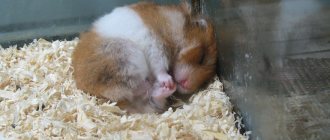Care and maintenance of Syrian hamsters
Syrian hamsters are very popular both in our country and around the world. Most likely, this is due to the unpretentiousness of maintenance, the resistance of the hamsters’ immunity, as well as their attractive appearance.
How many hamsters to get
The peculiarities of keeping them are that these animals prefer to lead an isolated lifestyle, while becoming attached to a certain territory, which they fearlessly defend. You need to know this in order to decide on the number of animals you plan to have. Therefore, they cannot be kept even in pairs, not to mention entire groups of animals. At the same time, it should be noted that there is a type of social hamsters - these are Roborovsky hamsters, which can be kept in whole groups without any problems.
Selection and filling of the cage
Syrian hamsters are relatively large in size, so a small cage is not suitable for keeping such a pet. In addition, the size of the cage must be such that it can accommodate a wheel with various labyrinths, as well as other accessories.
Article on the topic: LPR brake pads owner reviews
The best option can be considered a cage with dimensions of 37x27 cm and a height of about 36 cm. If the cage has two floors, then this is even better, since it is more convenient and more comfortable for the animal.
Features of the cell include:
- It is not necessary that the cage have several floors, but the main thing is that its dimensions are optimal.
- Dimensions should not be less than 50x30 cm.
- If the cage is too small in size, the animal may suffer from lack of movement, which leads to obesity.
- The second floor should be located at least 30 cm from the bottom of the cage.
- The door dimensions should be optimal, but not small.
- The distance between the rods is no more than 1 cm.
- It is better to get a cage that has a solid tray rather than a mesh one.
The hamster's home should be equipped with a special wheel, which will act as a gymnastic apparatus, and the bottom should be filled with sawdust, which can absorb moisture, as well as foreign odors.
Important point! The more game elements there are in the cage, in the form of a wheel, various manholes, steps and ladders, the more active the pet will behave.
Do not cover the bottom of the cage with cotton wool or paper. An excellent play element for a hamster in his home is a wooden driftwood with a smooth surface.
Rules of care and hygiene
Keeping a pet hamster requires deep cleaning of the entire home once a week. To do this, the upper part of the cage is removed and any remaining food, as well as bedding, is removed. As a daily activity, it is advisable to carry out partial cleaning, replacing the remaining feed and bedding that has become unusable.
After general cleaning, disinfection measures are mandatory using safe substances, after which the cage is wiped dry with a cotton cloth or paper towel. In addition, all additional elements of the cage, including bowls and drinking bowls, require regular washing. Cleanliness is the key to your pet’s health.
What to feed your Syrian hamster
Proper keeping of rodents such as Syrian hamsters at home is to provide the animal with a balanced diet, including various treats.
The use of ready-made, purchased food rations can be considered an ideal option, since they contain a sufficient amount of nutrients that are so necessary for the normal functioning of hamsters. In this case, you need to ensure that the feed is given in no more than the required portions.
Article on the topic: Reviews from Nissan Patrol Diesel owners
The feed should contain:
- Proteins – no more than 23 percent.
- Up to 6 percent fat.
- Within 10 percent fiber.
The hamster's main food products are solid grains in the form of wheat, oats and millet. If a pet has not finished eating and left food in the feeder, it must be removed immediately so that the pet cannot be poisoned by food that has become unusable.
It is important to know! Products such as citrus fruits, sunflower seeds (seeds), cabbage, chocolate and a number of other sweet products, including dairy and fermented milk products, with the exception of cheese, are contraindicated for feeding these animals.
As a rule, rodents' teeth grow throughout their lives, so it is necessary to create conditions for the animal to grind them down. To do this, the hamster is given branches of various fruit trees, such as apple and cherry, and also includes foods such as apples, carrots, persimmons, zucchini, turnips and raspberries in the diet.
Health and disease prevention
Pet hamsters may suffer from:
- For the appearance of abscesses.
- For dental problems.
- For obesity.
- For baldness.
- For inflammation of the “sacs”.
- On a “wet” tail.
- For herpes.
- For the spread of E. coli.
- For “false rabies” or Aujeszky's disease.
- For trichomoniasis.
- For conjunctivitis.
First of all, you should pay attention to the following symptoms:
- The appearance of sharp and unmotivated aggressiveness.
- The appearance of breathing problems.
- Complete apathy.
- Moisture fur and matted wool.
- The appearance of bald patches.
- The appearance of various wounds, swellings or ulcers.
- Loose or too dry stools that have an unusual color or unpleasant odor.
The owner should pay attention to the fact that the hamster is constantly trembling, and also to the fact that the pet is actively scratching its skin until wounds appear.
In any case, you should not self-medicate or try to establish a diagnosis yourself, which can only be done by a specialist. As a rule, many ailments manifest themselves due to poor care and maintenance, as well as the lack of a balanced diet. It is also necessary to pay attention to the conditions in which the cage is located, whether the room is well ventilated, and whether there are any drafts.
Reproduction and offspring
By the time of fertilization, the female must be at least 4 months old, and the male must be at least 3 months old. Successful mating is only possible if the female's estrus period is accurately determined, which occurs at intervals of 5 days. During this period, they take a female and a male and place them in a separate and very spacious cage.
Article on the topic: moll battery owner reviews
After fertilization, the female carries her offspring for 18 days. After this period, from 4 to 15 small hamsters may be born. Before the birth process, the cage is thoroughly cleaned, the bedding is completely changed, and a sufficient amount of food is poured into the feeder.
After childbirth, especially in the first days, it is undesirable not to disturb the female and her offspring. After birth, small hamsters feed only on mother's milk for a month.
During the period of feeding the offspring, as well as during the period of feeding with milk, the female’s diet should be enriched with:
- Due to protein products.
- Using boiled egg yolk.
- Due to low-fat cottage cheese.
- Using boiled chicken meat.
After birth, in no case should the cubs be touched with your hands, otherwise the female will be able to eat all her offspring if she senses the presence of foreign odors.
In addition, during this period it is advisable to place the cage in a fairly dark place, ensuring complete peace for the female and offspring. You can start breeding hamsters after they have lived for one month and one week.
How to take care of hamsters
The word “care” means not only feeding the hamsters and keeping them in good conditions. A pet needs real care, which manifests itself in:
- in maintaining cleanliness in the cage;
- protection from stress;
- in taking measures to prevent diseases;
- in regular communication with the animal.
Hygiene
One of the most important components of care is keeping the Syrian hamster clean. Cleaning the cage should be done every 5-7 days. During the procedure, the pet is placed in a carrier or box. The old filler is poured out, the tray and all equipment are washed with hot water. Places of heavy contamination are cleaned with soda solution. Household chemicals cannot be used. Then clean filler is poured in and the rodent is placed in the cage.
The Syrian hamster takes care of its own fur - it regularly washes its paws and tongue. Therefore, it is not recommended to bathe your pet, unless the animal gets dirty in something that cannot be licked off.
In this case, the contaminated areas are washed by hand; the animal is not immersed in water, so as not to frighten it. Under natural conditions, rodents bathe in dust. If there is a free corner in the cage, you can put a small container with clean river sand there. The hamster will take care of his coat there.
Disease Prevention
Syrian hamsters have fairly poor health. They often suffer from the following diseases:
- Conjunctivitis is an inflammation of the mucous membrane of the eye.
- Obesity. The main reason for weight gain is decreased physical activity.
- Diabetes. The disease is associated with disturbances in the functioning of the endocrine system.
- Inflammation of the cheek pouch. Damage to the oral mucosa with seed shells or other objects leads to infection of the wound and suppuration.
- Abscess. This capsule of pus in the form of a lump can form on any part of the body.
- Injuries - fractures, dislocations, bruises. Syrian hamsters often fall from heights. Sometimes this happens due to the fault of the owner, who lets the rodent wander around the table and does not keep an eye on it.
- Cold. The hamster is afraid of cold, draft and dampness. With poor care and improper living conditions, he can develop pneumonia or contract a viral infection.
Attention! Some diseases of small rodents are dangerous to humans. Therefore, every time after contact with a hamster and after care procedures, you must wash your hands with soap.
In order to provide timely help to a Syrian hamster, the owner needs to learn to recognize the signs of illness in the pet:
- lethargy, depressed state;
- tousled fur;
- lack of appetite;
- wet fur under the tail or on the neck;
- discharge from the nose and eyes;
- hard breath;
- trembling in the body;
- hair loss;
- scratches on the skin.
If the hamster hardly leaves the house even at night, then something is wrong with him. It is worth taking the Syrian to the veterinarian and following his recommendations.
Communication and domestication
You can start accustoming your pet to your hands 2-3 days after purchase, when the Syrian gets comfortable in the new place. The main thing is not to rush. You cannot immediately pick up a rodent - it may bite out of fear.
First, the owner has to prove that there is no threat emanating from him. You need to approach the cage several times a day and talk to the hamster in a quiet and calm voice. It is advisable to offer him a treat through the bars at this time.
When the pet gets used to the smell of hands, they move on to the next stage - communication through the open door. The owner holds a treat in his hand and waits for the animal to come up and take it. Very little time will pass, and the animal will become bolder: it will climb into the palm of your hand and calmly eat there. Now you can try to gently stroke the Syrian on the back, and then pick it up.
If you regularly pay attention to your hamster, there will be no communication difficulties in the future.
Active games
When caring for a Syrian hamster, it is very important to devote time to active games. Movement will help the animal stay healthy and cheerful. It is recommended to let your pet out of the cage every day and walk it in some spacious container with sides. You can build something like a maze out of a cardboard box - the hamster will certainly enjoy exploring new places.
The main thing is not to leave your pet unattended so that it does not run away.
Limiting stress factors
Small rodents are so sensitive that they can die from fear. The owner of a Syrian hamster must prevent the occurrence of situations that cause stress in the pet:
- sharp loud sounds;
- contact with a cat or dog;
- transportation unless absolutely necessary;
- communication with strangers;
- swimming in water.
Even a schoolchild can cope with caring for a Syrian hamster, because this animal is not too demanding. This is why many people prefer to have small rodents rather than cats or dogs.
Syrian hamster: reproduction, diseases
If you want to breed hamsters at home, buy a pair. Mature individuals are needed for mating. The female must be at least four months old, and the male - three.
Keep hamsters in separate cages until mating. Follow the process, otherwise the animals may harm each other. After the act, separate the couple again.
Djungarian hamster: care and maintenance, what to feed, photo
A hamster's pregnancy lasts only 18 days. Usually a female gives birth to about 5 cubs, but the number may increase. Breastfeeding lasts about a month. Females are not recommended to give birth more than four times a year.
Photo: pixabay.com: UGC
Before giving birth, you need to put the expectant mother in a separate cage and provide her with complete peace and secluded places. In a state of stress, the female is able to eat the offspring. Also, newborns should never be touched, just like the mother herself.
The Syrian hamster, whose photos are very cute, rarely gets sick with proper care. The most common problem is obesity. Therefore, under no circumstances allow your pet to overeat, and also monitor its activity.
Article on the topic: Subaru xv 2022 owner reviews
Hamsters: types and breeds, maintenance and care
As for diseases, hamsters can suffer from:
- parasite infestation;
- viral infections;
- fungal diseases;
- diseases caused by subcutaneous mites;
- conjunctivitis;
- stomach problems;
- tumors.
To avoid any health problems for your hamsters, clean the cage thoroughly and monitor your pet's diet properly.
Photo: pixabay.com: UGC
How can you tell if your hamster is sick? The animal becomes lethargic and inactive, mostly lying down. His fur may also become dull and his breathing may change.
If there is any deviation from the norm in the behavior or appearance of the hamster, contact your veterinarian. You cannot treat the animal yourself.
Syrian hamsters are charming and unpretentious animals. Therefore, if you decide to place such a pet at home, you will never regret it.
Talking parrots: the best breeds for home, care features
A unique selection of news from our editor-in-chief
Price for Syrian hamsters
The cost of a rodent depends on the color and type of fur of the animal - the more rare it is, the higher the price. In addition, it greatly depends on the place of residence of you and the animal itself: for example, in St. Petersburg the cost of this animal will be 100-150 rubles more expensive than in other cities, and in Moscow - 200-300 rubles. Some sellers can sell rodents for a very low price (in cases where the individual is sick or there are too many animals). Below is the average price in the city of Moscow for golden Syrian hamsters:
The character of the hamster and its acquisition
Before choosing a golden animal, pay attention to its behavior. Cute animals are not the same in character, each of them is a personality. If your hamster behaves aggressively, which is not so common, this may be a feature of his character. Ladies are more susceptible to attacks of bad mood. They are slightly larger than males.
As a rule, the Syrian hamster has a good disposition, quickly gets used to people, and willingly communicates with them.
Choose an active animal with a clean coat and no discharge from the nose or eyes. A healthy animal moves vigorously around the cage and does not itch constantly.
How to choose a hamster
To decide which hamster is better and make a really good choice, you need to pay attention to a few more points:
- Hamster gender. These rodents are not sterilized, so you need to take into account that the smell will be stronger from the male. This means that his cage will have to be cleaned more often. The reason is that the male tends to mark his territory everywhere. But at the same time, it is the males who are more affectionate and patient.
- Age of the rodent. Regardless of the breed, it is better to buy a month-old baby or a little older. Younger hamsters may die, and those who are more than two months old have a more difficult time getting used to new living conditions.
- External condition. You need to visually inspect your future pet. The animal's fur should be shiny, clean and without bald spots. Discharge from the nose or eyes and diarrhea are unacceptable. All mucous membranes must be clean.
- Hamster behavior. A healthy animal is active. Feels comfortable in your hands.
Hamsters are usually bought at the market, pet store or nursery. The first option should be discarded immediately - the chances of purchasing a sick or old animal are high. It is best to go to a nursery to get your hamster. Here the breeders know everything about their charges and will definitely give advice on keeping the animal. They can also share a phone number where you can get advice if any problems arise. And the animals in the nursery are usually sold already tame.
Despite the fact that hamsters are not whimsical, you need to approach their purchase seriously. After all, these are living beings that need care and love.
Diseases
In general, such an animal is in good health. With proper care, your pet will feel good.
An animal may become ill if:
- does not eat properly;
- sleeps on damp bedding;
- there are sharp objects in the cage;
- the humidity in the room is too high or low;
- it lacks movement.
Article on the topic: Motoblock Ugra reviews from owners
A healthy rodent has a dry nose, thick silky fur, a clean anus and eyes.
What are the most common diseases of Syrian hamsters? Now we list them:
- colds (sneezing, nasal discharge, chills);
- pneumonia;
- clogged or damaged cheek pouches;
- diarrhea;
- skin diseases;
- conjunctivitis;
- lymphocytic choriomeningitis (the main symptom is photophobia).
Always monitor your pet's health. The first symptoms of the disease may be the following:
- loose stools,
- manifestation of aggression;
- fur loss;
- the appearance of fleas;
- formation of wounds on the skin;
- difficulty (heavy) breathing;
- the appearance of ulcers on the skin;
- slightly damp wool to the touch;
- apathetic state of the animal.
Have you noticed any alarming symptoms? Go to the vet immediately!
Ten reasons to get a hamster
Good for baby
Having an animal in the house is always a big plus in raising children. By caring for a pet, a child learns responsibility and discipline.
Easily tamed
The hamster quickly gets used to hands. But he also quickly gets used to them. Therefore, if you want your pet not to be afraid of your caresses, take it in your palms more often and hold it carefully and gently, without squeezing or hurting it. This should be very pleasant not only for you, but also for him. You can train the animal to take food from your fingers. A hamster can learn to respond to its name, crawl out of the house, and run up when called. But this is achieved only with constant “communication” with him.
The hamster is easy to care for
There are many pros and cons to getting a hamster, but this one is worth highlighting. To keep a hamster at home it is enough:
- purchase a cage with a minimum size of 30x50 cm;
- clean it at least once a week;
- water and feed two times a day good food.
Hamsters do not need to be bathed, walked, or combed. They don't get bored if their owners leave for a long time. They don't need expensive accessories and toys, shampoos and other care products.
The animal is unpretentious in food
In the wild, hamsters eat both plant and animal foods. Any pet store sells dry grain mixture. The hamster can be fed fresh vegetables, fruits, herbs, bread, milk and cottage cheese. It is allowed to offer even dry dog or cat food. He needs very little food, only 10-20 g per day, so you can afford to spend money on elite food. You cannot give food from your table, especially if it is fatty, salty, spicy or fried.
Article on the topic: Pyrolysis boilers reviews from owners
Totally positive
Every owner of a furry pet knows why hamsters are needed. For positive emotions, to lift your spirits. When a warm fluffy lump sits in the palm of your hand and trustingly looks at you with its beady black eyes or, holding a piece of carrot with its front paws, funny moves its antennae, all the troubles of the past day disappear without a trace and are forgotten. The hamster plays funny, runs around in a wheel, in a special transparent ball and amuses the whole family. He never sits still.
If the first five reasons have already convinced you to get a pet, then before purchasing we strongly recommend that you read our article on choosing the right hamster
Breeding
When getting acquainted with the pros and cons of keeping hamsters in an apartment, one cannot help but think about the relationship between the sexes. It’s interesting to watch courtship, but it’s even more interesting when offspring appear in a rodent family. This event will be the most memorable for the kids. It will be educational and useful for them to watch how tiny mom and dad take care of their offspring, how blind pink worms become fluffy and adult hamsters in just a month.
Variety in choice
Comparing the characters, habits and external signs of the many types of hamsters, a person most often chooses Djungarian and Syrian hamsters for home keeping:
- Syrian hamsters are popular hamsters up to 20 cm in size. They have a kind, calm character and are well trained. After years of being kept in captivity, the initially golden fur can now come in a wide variety of colors and lengths. Lumps in which you can’t tell where the tail is and where the muzzle is – this is a variety called Angora;
- Djungarian - nimble, small (up to 10 cm), hairy-legged, very beautiful hamsters with light fur and a dark stripe along the back;
But before you decide whether to get a Djungarian or Syrian hamster, you should also pay attention to other breeds, for example:
- Roborovsky's hamsters are the smallest (up to 5 cm) hamsters, distinguished by their protruding ears and collectivism. They love to live in friendly company and hardly smell;
- Campbell's hamsters are small (up to 10 cm) with furry legs and not a very friendly character.
They get sick a little
Compared to other pets, hamsters are not susceptible to many diseases. If their cage is not in a draft, if the animals are not shaking from the cold and are not suffocating from the heat, they will happily live their short lives without getting sick. Symptoms of illness are the same as in all animals. Timely diagnosis will help quickly cure your pet. When choosing a breed, going through all the pros and cons of Djungarian hamsters in the house, the fact that they get sick less than others can be decisive.
Article on the topic: Daihatsu Sirion owner reviews
Not expensive
Even the most expensive and rare breeds of these rodents are much cheaper than a British cat or a good shepherd dog. On average, the price of hamsters in our time varies from 100 to 500 rubles and depends on the breed and age of the animal. Items and accessories for its maintenance can be purchased for 1-2 thousand rubles. The only thing cheaper than a hamster are mosquitoes.
Communication skills
While in many other animals their attitude towards people depends on their character, experience, and training, the hamster loves and plays with everyone. He is trusting, quickly gets used to affection and also quickly forgets insults.
Pet hamster
The hamster belongs to the rodent family and reaches sizes from 5 to 35 centimeters in length, a tail from 0.5 to 10 cm. The animal has a distinctive feature - cheek pouches. They have a variety of colors and fur lengths. Hamsters live for about 3 years, large individuals can live up to 7 years.
Hamsters are territorial animals. If you decide to buy two hamsters, then they will not get along in one cage.
Children mostly pay attention to rodents. They see one of their friends with an animal and ask for the same one. There is no need to say no, because the fluffy will become a true friend to the child.
Do not get an animal if family members are allergic to wool and its waste products.
Method 1. Ideal habitat
1. Provide enough space. Your hamster may seem to sleep most of the time, but at dusk he becomes active and needs space to play. Provide as much space as you can! The hamster uses different parts of the cage for different activities and there should be sufficient distance between them.
So: cage dimensions: 30x30x50 cm. Bigger is better.
- Mesh cages and aquariums, plastic and glass, are also suitable. Each option has its own advantages and disadvantages. A lattice cage provides more climbing space but takes longer to clean.
- Make sure that the bottom of the cage is deep enough, at least 3-5 cm, and take care of high-quality filler.
2. Make sure there are enough toys. Hamsters are active creatures who spend a lot of time having fun and playing. The wheel is necessary, but they alone cannot do it:
- Wooden twigs and other shaped toys are not only fun, they help maintain the proper shape of your teeth. The tree must be clean and safe.
- You can make toys yourself. For example, an empty cardboard box is both a play tunnel and a chew item.
- And if you fill a small box with special shavings, the hamster will happily dig around in it.
- Do not use cardboard with glue or paint residue.
3. Give the hamster a wheel. A win-win option for running and channeling energy into a peaceful direction. The wheel must be made of a smooth material, in no case from mesh! If your hamster gets stuck between the bars, it can injure its paw.
- Large wheels designed for rats are also suitable for hamsters.
- Another option that allows you to run for a long time is a special ball.
- Lure the hamster out of the cage by placing a ball at the entrance and pretending you don't care. Make sure the room is safe and there are no other animals.
Article on the topic: Mitsubishi Pajero mini owner reviews
Choosing a location for the cage
Often owners do not pay attention to where to place the hamster's cage. This is a rather important point, which affects both the health and life expectancy of the animal.
Things to consider when choosing a location for a cage:
- Avoid direct sunlight on the cage;
- avoid bright light;
- limit access to the cage for other animals;
- avoid drafts;
- there should be no temperature changes in the room;
- do not place under air conditioning;
- do not place near heating devices;
- there should be no strong odors or smoke in the room;
- do not place near a TV, radio, or stereo system;
- do not place the cage in a walk-through area;
- Do not place it in a children's playroom, as hamsters are afraid of sharp and loud sounds.
For the cage you need to choose a quiet, non-passable place. The cage should not be moved frequently. The optimal temperature for keeping hamsters is 20-25 degrees.
It is necessary to install a house in the cage so that the hamster can rest during the daytime and feel safe. Also in the cage you need to put 2 feeders and a drinking bowl. Feeders with drinking bowls must be attached to the bars of the cage, otherwise an active animal will definitely turn over and trample the contents. One feeder is needed for the grain mixture, which is the main feed, the other is needed for succulent feed.
It is worth considering that hamsters are very mobile and active animals. They definitely need to buy and install a treadmill, ball, tunnels, and labyrinths in the cage. Special playgrounds for hamsters are sold, which already include the listed attractions, as well as various toys for the hamster.
How do hamsters differ depending on the variety?
The hamster is one of the most popular pets. If you decide to get a hamster for yourself or your child, then you have to figure out which hamster to choose, what gender and age. The character of the pet depends on this, what kind of relationship there will be between you, how long the rodent will live and how difficult it will be to care for it.
Now we are interested in the varieties of hamsters: let’s figure out what their differences are and how to determine which variety is best for you.
The most popular varieties of domestic hamsters
There is a huge variety of species and subspecies of hamsters, but the most popular for home keeping are:
Each variety has its own characteristics. Animals differ from each other in temperament, size, and life expectancy. Let's look at each of them in more detail.
Dzungarian (Sungur) hamster
Dzungarian and Sungur are the names of the same hamster, but in everyday life it is simply called “Djungarik”. This rodent grows up to 10 cm and is considered one of the smallest among domestic hamsters. Weight – up to 50 grams. Djungarians have a very short life expectancy: only 1.5-2 years. Only a select few live to be 3 years old. The legs of the dwarf are covered with hair, the fur on the back is dark, and on the tummy it is light. A characteristic external feature of this variety is a dark thin stripe along the back.
For small children, dzhungarikas are not the best choice, because they are very small, fragile and mobile creatures. It will be difficult for the child to hold the nimble baby in his hands, and the hamster will run away. By nature, dzhungarikas are very shy and secretive creatures. They need to be taught to handle from a very early age, otherwise an adult may even behave aggressively.
A rodent accustomed to humans will be very affectionate and friendly. Some dzhungarikas happily sit in the owner's arms and even fall asleep on them.
Djungarians do not get along with other representatives of the hamster family or do so reluctantly. This animal is kept mostly alone in a cage.
Article on the topic: Mitsubishi Outlander 2013 owner reviews
The diet of the dzhungarik should consist only of permitted and healthy foods, otherwise the animal will get sick and die prematurely.
Syrian hamster
Quite a large variety among domestic hamsters. Individuals reach a length of 15-20 cm and live 2-3 years. In good conditions they can live up to 4 years.
Unlike dwarf hamsters, Syrian hamsters are more suitable as a pet for children. They are large and easier to hold in your hands.
Being Syrian has several advantages:
they live longer than other hamsters. At the same time, they do not require special and complex care;
You can choose a Syrian hamster by color and coat length. The coat color is most often red, but can be yellowish or peach. But as a result of selection, other colors were obtained. The Angora hamster is a long-haired variety of the Syrian. You can choose it if you want a fluffier pet, but you will have to take care of the fur so that your pet looks neat;
Syrian hamsters easily make contact with people, quickly get used to being handled and know their owner. Even after separation, the Syrian will not forget his person and will be very glad to meet him.
There is only one downside to Syrian hamsters - their large size, which is why you will have to buy a spacious cage. Syrians need a lot of loopholes, tunnels, wheels, because this species is very active and mobile. They are kept alone, because... The Syrian can conflict with other hamsters.
The peculiarity of the Syrians is 4 toes on the front paws and 5 toes on the hind paws.
Roborovsky's hamster
This variety is the only one among domestic hamsters that can be kept in groups. But it is better not to house individuals of different sexes together to avoid conflicts.
Robokovsky's hamsters are the smallest, even smaller than dwarf hamsters. Their dimensions do not exceed 5 cm in length. Life expectancy is up to 2 years. The cost of a hamster is high due to the fact that representatives of this species reproduce poorly and are not as common as others.
Life expectancy is almost the same as that of Syrians - 4 years with quality care. But by nature they are more independent and willful than Syrian hamsters.
If it is important for you to touch, stroke and hold your pet, then the Robokovsky hamster is unlikely to become the pet of your dreams. It is very difficult to accustom him to handling, he behaves separately. The best thing you can do is observe the lives of your tiny pets from the outside.
Article on the topic: Subaru xv 2022 owner reviews
Campbell's hamster
These hamsters reach a length of 8 cm and live on average 2 years. Campbell's hamsters look like dwarf hamsters, but they have several distinctive features:
the color of the fur coat has a golden tint, while the Djungarians have darker fur;
if you look at the rodent from above, the dwarf hamster has an oval shape, and the Campbell's hamster has a figure eight shape;
Campbell's hamster also has a dark stripe along its spine, but it is not as pronounced as that of the dwarf hamster.
Like the Robokosky hamster, the Campbell's hamster is very rare and almost impossible to find in pet stores. Mostly they are bought from breeders. But even from them you shouldn’t thoughtlessly buy an animal. It is first important to make sure that the fluffy is not wild and is used to being handled, otherwise an aggressive pet will bring you nothing but disappointment.
Common or forest hamster (karbysh)
If you contact sellers in pet stores and ask them about the availability of an ordinary hamster, they are unlikely to understand you and will offer you any other variety. It is worth considering that the common or forest hamster (aka carbysh) is a wild rodent and pest that destroys crops and harms crops.
It is not recommended for home keeping. But many people don’t care about this, and they get a forest dweller at home. Despite its aggressiveness and love of freedom, the karbysh can still get used to a person, but only to one, whom it will consider its master. A wild hamster will be indifferent at best to other family members.
Among hamsters, the karbysh is a real giant: 20-35 cm in length, including a tail about 8 cm long. The ordinary hamster is not only a giant, it is also a long-liver: in the wild it can live up to 4 years, and in good conditions - up to 6 years. Karbysh is loved for his beautiful tricolor color and active behavior, which is interesting to watch from the outside.
An ordinary hamster needs to be kept alone; it will not get along with other rodents. You can’t keep a carbysh for children: this rodent is not human-oriented. The animal needs a special approach and careful handling, otherwise it will not seem small.
These were the most popular hamsters. Be sure to take into account the temperament and living conditions of the variety you have chosen so that the animal lives a happy life and brings you only positive emotions.
Hamster - what kind of animal is this?
Hamsters are tiny animals, a bit like their relatives rats and mice, because, like them, they belong to the class of rodents. Their colors can be very diverse - from black and white to golden. Pets adore a nocturnal lifestyle, so they diligently get enough sleep during the day so that they can be more active at night. The most popular breed of hamster is the six-inch Syrian hamster . It has a golden color and very fluffy fur. The life expectancy of this breed is from 2 to 3 years . Other breeds - Djungarian, Chinese and Siberian hamsters live up to 18 months .
Syrian hamster
It is necessary to feed hamsters with dry factory food, which has a balanced composition and contains all the necessary vitamins and minerals. In addition to this, the hamster’s diet can include succulent food in the form of dried grass, dried vegetables and fruits.











